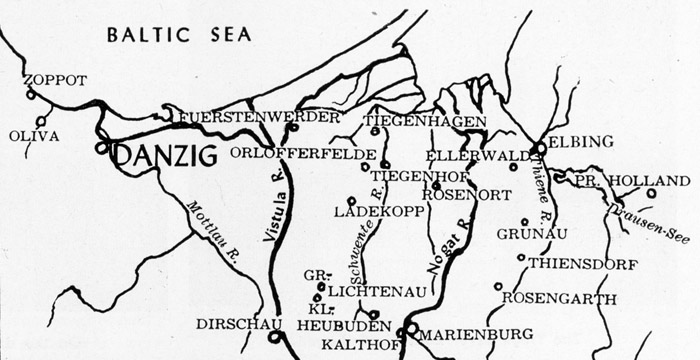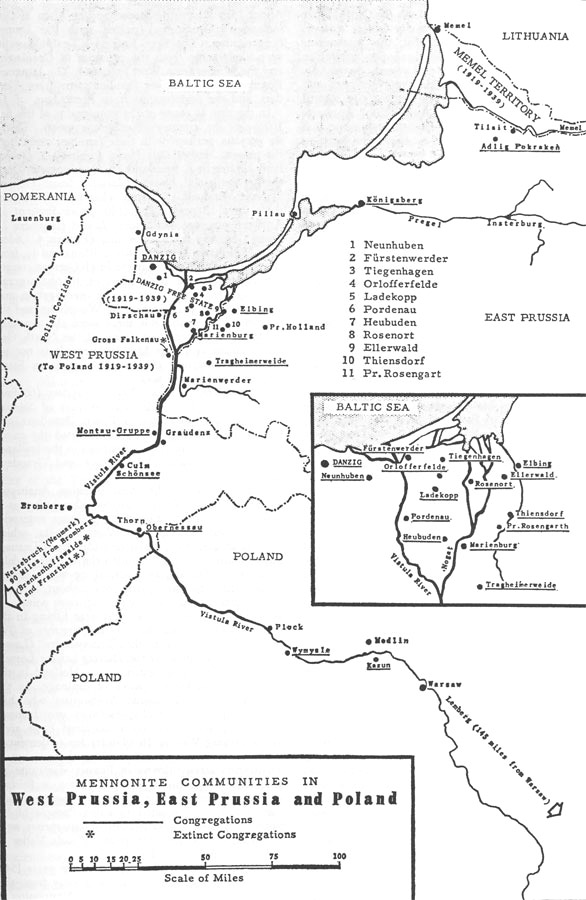ERIC KRAUSE
In
business since 1996
- © Krause House
Info-Research Solutions -
_____________________________________________________________________________________
BACKGROUND GENEALOGY
Danzig

http://www.bethelks.edu/mennonitelife/2004Mar/regier.php
Vistula Delta

http://www.gameo.org/images/ME4_921.jpg/image_view_fullscreen
https://mla.bethelks.edu/ml-archive/2012/Danzig.jpg
Immigration from Germany to Eastern Europe (Ostsiedlung) ...
Emigration Countries of Origin Areas of Settlement ....
Period
1789-90 Danzig, West Prussia Chortiza (Mennonites) ....
1804-06 Danzig, West Prussia Halbstadt, Molotschna (Mennonites) ....
1853 Danzig, West Prussia Samara (Mennonites) ....
Vistula delta Mennonites were a historic Mennonite community, established in the mid-16th century in the Vistula river delta in Poland. It originated from the Netherlands and present-day northern Germany. The Mennonite community played an important role in the drainage and cultivation of the Vistula delta and the trade relations with the Netherlands. In the late 18th century a significant number of Mennonites emigrated further and formed the nucleus of the Mennonite settlements in Russia, while many remained in the region after the annexation of the region by Prussia in the Partitions of Poland ....
Danzig community
The first Anabaptist in the area, a local resident, is reported in 1526 in Marienburg (Malbork). In the 1530s, Dutch Mennonites from what is now the Netherlands and Belgium moved to the area of Danzig (Gdańsk) Poland's principal seaport, which was connected to the Low Countries by traditional grain trade. Menno Simons apparently visited the community in 1549 and in 1569 Dirk Philips founded the first Mennonite Church in Danzig. Soon about 1,000 Mennonites lived in the city.[2][3][4] Mennonites enjoyed religious freedom in traditionally tolerant Poland, which was officially confirmed since the Warsaw Confederation of 1573. Former Mennonite Church in Gdańsk
In 1552, the Danzig city council allowed Mennonites to practise their faith but refused to grant Mennonites the formal status of a Citizen, a situation unchanged until the city was annexed by the Kingdom of Prussia in the Second Partition of Poland in 1793. As a result, most of them settled in the suburbs of Schidlitz (Siedlce), Petershagen and Alt-Schottland (Stare Szkoty).[5][6] The relation between the city council and the Mennonites was often ambivalent. Though their faith was tolerated in general, protests of local craftsmen caused the ban of Mennonite traders and craftsmen to participate in the annual trade fairs. In 1582, local guilds’ complaints against the employment of Mennonite linen weavers by the Catholic St. Bridget's Church were judged by the city council, which decided to limit the number of Mennonite weavers to one per abbey. In 1583, the council unsuccessfully requested the Polish King to dislodge the Mennonites in the suburb of Alt-Schottland while in 1586 the King asked the council not to tolerate this “human plague” inside the city.[6]
However, the Mennonite community in Danzig grew and played an important role in grain trade with the Low Countries. ...
Vistula Delta settlement ...
While a liberal “Friesian” group of merchant traders were part of the Danzig community, a more conservative “Flemish” group dominated along the Vistula. ...
Plautdietsch, a mixture of Dutch and the Low Prussian dialect of the Vistula Delta, became the typical language of the Mennonites in this region.[11] The first German-language sermon in the Mennonite Church of Danzig in 1762 caused protests by community members and led to a return to the Dutch language.[12] The use of High German language would become one of the basic motivations for subsequent migrations to Russia. ...
In 1772, the Vistula delta and the Danzig suburbs became part of the Kingdom of Prussia after the First Partition of Poland, the city itself after the Second Partition in 1793, at that time 577 Mennonites lived within the city.[10]
In 1772, 12 032 Mennonites lived in the now Prussian territory. Though their faith was tolerated, the Mennonites became subject to special laws and extra taxes. Only men who had served in the Prussian Army were allowed to purchase land tenure, conscientious objectors were subject to special charges. These regulations led to a large number of young Mennonites without economic prospects.
In 1786, Georg von Trappe, a colonization agent of the Russian government, sought to recruit settlers for the regions recently conquered from the Ottoman Empire. In the following decades, about 6000 Mennonites, most of them from the delta settlements,[13] left for Russia, forming the roots of the Russian Mennonites.[14] The first Mennonite settlement in Russia, Chortitza Colony, was founded by these emigrees in 1789.[2]
The Mennonites who remained in the Vistula delta assimilated more and more. In the War of the Sixth Coalition, some young Mennonites were prepared to join the forces against Napoleon. In the Spring of Nations of 1848, Mennonites joined the armed municipal militia (Bürgerwehr), which included the right to bear arms. When, after the foundation of the North German Confederation, a general conscription was invented, the Danzig community managed to receive the exceptional permission to serve only in non-combat troops; however, a group of Mennonites emigrated to North America to avoid all kind of military service.[13] ...
https://en.wikipedia.org/wiki/Vistula_delta_Mennonites#Danzig_community
Those Mennonites from Holland who migrated to Danzig and the surrounding area during the mid 16th century maintained close ties with Holland. For at least two centuries after their arrival in Danzig the Mennonites remained in contact with their religious counterparts in Holland. There is evidence that the first Mennonites came to Danzig from Holland in 1529. For the next 20 years the growing Mennonite community met in private homes, in barns and open fields for their worship services. It was Menno Simons, a Dutch Mennonite leader from Witmarsum Friesland who, in 1549, began to organize the growing Mennonite community in Danzig into a congregation. ....
The Dutch language was used in church services and in Mennonite homes in Danzig' until 1780 when the Mennonite. community lost "much of its strength as a result of the large Mennonite migrations to the Ukraine (It is estimated that three-quarters or 2,000 of 2,890 members of the Mennonite community in Danzig resettled in Russia at that time). After the rapid decline of the Mennonite church community in Danzig, the process of acculturation accelerated and High German began to take the place of Dutch used in church services and in the homes the Plattdeutsch spoken in the area came into use. ...
What characterized the Mennonite community in Danzig and the surrounding area was a division, which had already occurred among the Mennonites in Holland between the Flemish and Frisian Mennonites. From approximately the late 1560's to the 1860' s these two factions actually became two distinct congregations which existed side by side. The spiritual division between the Frisian and Flemish groups was to a degree compounded by their geographical division. The majority of the Flemish lived in Danzig, the Grosser Werder and Elbing Werder whereas most Friesians lived in the Marienburger Werder and in the Weichseltal area. The Flemish faction maintained the largest congregation and considered itself the real Danzig Mennonite Church. Indeed until 1786 it was customary for the Flemish to rebaptize members of the Frisian group that sought membership in the Flemish Congregation. The Flemish group called itself the fine and pure ones, "Die Feinen und Klaren." The Fresians, who were more liberal, on the other hand, considered themselves the Coarse Ones - "Die Groben."...
https://caans-acaen.ca/Journal/issues_online/Issue_II_i_1980b/Dyck-Tiessen.pdf - MENNONITES IN DANZIG: DUTCH ORIGINS AND TIES Linda Dyck~Tiessen Leamington, Ontario